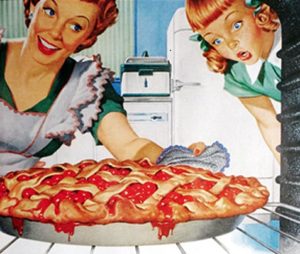The thing about being raised a Baptist in south Louisiana was that you ended up missing out on half the fun. Most of the idiosyncratic practices and traditions that gave shape to the local culture were at least loosely related to some kind of Catholic observance. For many Baptists, even the slightest taint of Catholicism meant that custom was just one step removed from paganism. To protect our souls, these activities were strongly discouraged. Which made them irresistible to us kids. We had our workarounds.
Pie Day was a Good Friday tradition where I lived. I was in the fourth grade before I ever got to go to one. In my family, we turned our noses up at the entire liturgical calendar, so I barely even knew what Good Friday was, though I had some sense it involved bleakness, wailing, and gnashing of teeth. How all that went with pie, I had no idea. But this was Louisiana; we learned early to live with contradiction.
That year, I was at a friend’s house on the Thursday before the Friday before Easter. The kitchen was packed with women laughing and rolling out “sweet pie dough,” as we all called it, with empty wine bottles. “Come on over tomorrow, Ed — it’s Pie Day,” Ms. Linda smiled.
Ms. Linda knew that I knew that she knew she was inviting me to transgress. But there would be pie. How could one go wrong with that? I also noted a seductive whiff of paganism. Looking left and right, I said, “Sure. When?”
“All day,” she said. “OK,” I said.
Later, I asked my friend, “You just have pie all day?” The answer was yes. “You just eat whatever pie you want,” he said. “Oh,” I said.
 The next day, I showed up midmorning. Entering through the kitchen door, I found before me the most astounding display of pie I had ever seen in all my 10 years. Fruit pies and cream pies and chess pies and hand pies covered the counters and the kitchen table. Like a great river, the pies flowed from the kitchen into the living room, where they occupied the coffee table and every inch of the folding card tables set up there. Around me, adults and kids alike were holding little paper plates and plastic forks, scooping every imaginable kind of pie into their mouths.
The next day, I showed up midmorning. Entering through the kitchen door, I found before me the most astounding display of pie I had ever seen in all my 10 years. Fruit pies and cream pies and chess pies and hand pies covered the counters and the kitchen table. Like a great river, the pies flowed from the kitchen into the living room, where they occupied the coffee table and every inch of the folding card tables set up there. Around me, adults and kids alike were holding little paper plates and plastic forks, scooping every imaginable kind of pie into their mouths.
More guests arrived bearing yet more foil-covered dishes, and as soon as one pie was consumed, another took its place. I struggled to discern the soul-threatening evil that lurked among the pies. “Come on,” said my friend, and we began our close survey of the offerings. I decided that maybe there was something to this Catholicism thing.
Celebrated throughout south Louisiana among Cajuns, Pie Day is likely a carryover from a very old French Good Friday observance called jour de tarte. As no work was allowed on Good Friday, all food for the single-meal fast day was prepared on Maundy Thursday in the form of pies that could be eaten cold.
Rural Louisiana towns often lacked clergy, and so its traditions have a bit of a do-it-yourself quality to them. As this observance developed, the one meal of Good Friday became a day-long feast of pies that began in the morning and continued for hours until the midafternoon Mass.
For a time, the church tried to suppress the peculiarly celebratory custom as unseemly for the solemnity of Good Friday. But the effort was unsuccessful. The tradition has taken different forms in different villages. In some locales, the hosts prepare all the pies, while in others guests arrive with their contributions. In some places, only sweet pies are offered, but this is not universally true; in some locales crawfish pie is found in the mix. And as the custom experiences something of a revival, now even pizza pies can be found on Pie Day tables.



